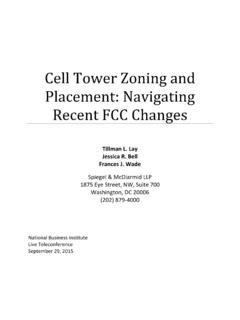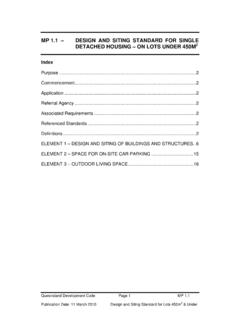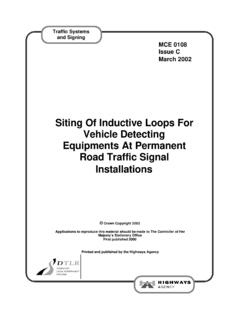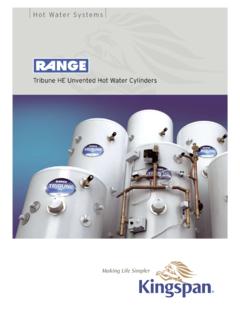Transcription of Wireless Facilities Siting in the Wake of the Spectrum Act ...
1 Wireless Facilities Siting in the Wake of the Spectrum Act and RoswellTillman L. LayJessica R. BellSpiegel & McDiarmid LLP1875 Eye Street, NW, suite 700 Washington, DC 20006(202) 879-4000 Local Government Attorneys of VirginiaSpring 2015 ConferenceHyatt Regency Reston HotelApril 25, 2015- i -About the AuthorsTillman L. Layis a partner in the Washington, , law firm of Spiegel & McDiarmid LLP. He specializes in representing local governments and other clients on telecommunications, cable television, franchising, public safety, municipal broadband, rights-of-way, tax, property law, land use, constitutional law, antitrust and other federal law matters before the courts, the Federal Communications Commission (FCC) and Congress. His clients include scores of local governments across the nation. He has represented local government clients before the FCC, the courts and Congress on Wireless Siting issues. He also testified before a House Subcommittee on behalf of the National Association of Counties, the Conference of Mayors, the National League of Cities and the Government Finance Officers Association against legislation that would impose a moratorium on state and local cell phone taxes.
2 He received his undergraduate degree with highest honors from the University of Tennessee, and he is a magna cum laudegraduate of the University of Michigan Law School. After law school, he clerked for the Honorable John C. Godbold, Chief Judge of the United States Court of Appeals for the Fifth Bellis an associate at Spiegel & McDiarmid LLP. She has worked on a range of telecommunications, transportation, environmental,and energy matters. She graduated cum laude from Wellesley College and received her from the Columbia University School of Law. After law school, she clerked for the Honorable Andrew M. Mead of the Maine Supreme Judicial Court and completed a two-year Honors Attorney Fellowship in the Office of General Counsel of the United States Environmental Protection Agency. Spiegel & McDiarmid LLP- ii -Table of ContentsI. The FCC s Wireless Siting Report and ) Background on the Section 6409(a)..22. Section 332(c)(7) and the Shot Clock Historic Preservation and Environmental ) The FCC s Final Section 6409(a).
3 52. Section 332(c)(7)..93. Historic Preservation and Environmental ) South, LLC v. City of ) ) The Court s ) What RoswellMeans for Local ) ) Text of Section 332(c)(7)..18B) Text of Section 6409(a)..19 Spiegel & McDiarmid LLP- 1 Telecommunications Act of 1996 ( TCA ) preserved most state and local zoning authority over the Siting of personal Wireless service Facilities while preempting certain exercises of that authority in order to balance local concerns with a growing need for Wireless deployment. With the Middle Class Tax Relief and Job Creation Act of 2012,Congressenacted another provision, Section 6409(a),1to promote Wireless Siting by further restricting a local government s ability to deny certain Wireless applicationsthat seek to modify existing Wireless Facilities . Over the past year, the Federal Communications Commission ( FCC or Commission ) and the Supreme Court have spoken on Wireless Siting issues, and local governments may need to adapt their practicesto conform to those actions.
4 This paper discusses the FCC s recent rulemaking to implement Section 6409(a) andclarify Section 332(c)(7)2of the TCA, as well as the Supreme Court s decision in T-Mobile South, LLC v. City of FCC S Wireless Siting REPORT AND ORDEROn October 21, 2014, the Commission released a Report and Order in its Wireless Siting rulemaking This rulemaking primarily addressed the implementation of Section 6409(a), but also addressed the operation of Section 332(c)(7), five years after the FCC s Shot Clock 147 1455(a) ( Spectrum Act ).247 332(c)(7). 3T-Mobile S., LLC v. City of Roswell, 135 S. Ct. 808 (2015).4In re Acceleration of Broadband Deployment by Improving Wireless Facilities Siting Policies, Report and Order, FCC 14-153, Oct. 21, 2014, WT Docket No. 13-238, 29 FCC Rcd. 12,842, 80 Fed. Reg. 1238 (Jan. 8, 2015),available at ( Order ).5 Petition for Declaratory Ruling to Clarify Provisions of Section 332(c)(7)(B) to Ensure Timely Siting Review and to Preempt Under Section 253 State and Local Ordinances that Classify All Wireless Siting Proposals as Requiring a Variance,Declaratory Ruling, FCC 09-99, Nov.
5 18, 2009, WT Docket No. 08-165, 24 FCC Rcd. 13,994, 74 Fed. Reg. 67,871 (Dec. 21, 2009)( Shot Clock Ruling ), petition for review denied in part and dismissed in part, City of Arlington, Tex. v. FCC, 668 229 (5th Cir. 2012), aff d 133 S. Ct. 1863 (2013). Spiegel & McDiarmid LLP- 2 -A)Backgroundon the Rulemaking In early 2014, the FCC sought comment on a proposed rulemaking directed atwireless Facilities Siting The FCC proposedrules to clarify and implement Section 6409(a) of the Middle Class Tax Relief and Job Creation Act of 2012, to address implementation of the Shot Clock Ruling, and to expedite its own environmental and historic preservation reviewof certain Wireless deployments. 6409(a)The Spectrum Act was enacted as part of the Middle Class Tax Relief and Job Creation Act of 2012. The Spectrum Act was generally intended to advance Wireless broadband service for public safety and commercial purposes and provided for the creation of a broadband communications network (known as FirstNet ) for first responders.
6 As recommended by the 9/11 6409(a) of the Spectrum Act provides, in pertinent part, that a State or local government may not deny, and shall approve, any eligible Facilities request for a modification of an existing Wireless tower or base station that does not substantially change the physical dimensions of such tower or base station. 8 While Section 6409(a) has applied to all local governments since its enactment in 2012, the language s ambiguity has led to different interpretation by industry and local governments. What is an eligible Facilities request ? What is a substantial change to the physical dimensions of a tower or base station ? What is an existing tower or base station ? Is Section 6409(a) even constitutional? In its September 26, 2013, NPRM, the Commission tentatively found that it would serve the public interest to establish rules clarifying the requirements of section 6409(a) to ensure that the benefits of a streamlined review process for collocations and other minor facility modifications are not unnecessarily delayed.
7 9 6In re Acceleration of Broadband Deployment by Improving Wireless Facilities Siting Policies, Notice of Proposed Rulemaking, FCC 13-122, Sept. 26, 2013, WT Docket No. 13-238, 28 FCC Rcd. 14,238, 78 Fed. Reg. 234 (Dec. 5, 2013), available ( NPRM ). Rep. No. 112-399, at 136 (2012), reprinted in 2012 186, 220. 847 1455(a). 9 NPRM 95. Spiegel & McDiarmid LLP- 3 -In its rulemaking, the Commission proposeddefining various termsin Section 6409(a), clarifying Section 6409(a) application procedures, deciding whetherSection 6409(a) applies to local governments as property owners, and possible remedies. 332(c)(7) and the Shot Clock RulingSection 332(c)(7) provides for limited preemption of state and local zoning authority in the Siting of personal Wireless service Facilities . The statute disallows unreasonable discrimination among providers of functionally equivalent services 10and local government actions that prohibit or have the effect of prohibiting the provision of personal Wireless services.
8 11 State or local governments may not regulate Wireless Facilities on the basis of the environmental effects of radio frequency emissions to the extent that a facility complies with FCC regulations on such State or local governments are also required to act on any request for authorization to place, construct, or modify personal Wireless service Facilities within a reasonable period of time. 13 The statute requires denials to be in writing and supported by substantial evidence14and provides for expedited judicial more than a decade after its 1996 enactment, interpretation and application of Section 332(c)(7) was the province of the courts Section 332(c)(7)(B)(v) provides for judicial review. In response to a 2008 industry petition, the Commission took up the question of what constitutes 1047 332(c)(7)(B)(i)(I). See AT&T Wireless PCS, Inc. v. City Council of Va. Beach, 155 423, 426-28 (4th Cir. 1998) (finding no unreasonable discrimination).
9 1147 332(c)(7)(B)(i)(II). See New Cingular Wireless PCS, LLC v. Fairfax Cnty. Bd. of Supervisors, 674 270, 275-77 (4th Cir. 2012) (discussing what constitutesa prohibition under Section 332(c)(7)(B)(i)(II)); APT Pittsburgh Ltd. P ship v. Penn Twp. Butler Cnty., 196 469,480 (3d Cir. 1999). 1247 332(c)(7)(B)(iv). But see Sprint Spectrum v. Mills, 283 404, 420-21 (2d Cir. 2002) (upholding governmental entity s lease provision addressing radiofrequency emissions). 1347 332(c)(7)(B)(ii) (emphasis added). 1447 332(c)(7)(B)(iii). See Rep. No. 104-458, at 208 (1996), reprinted in 1996 124, 223 ( The phrase substantial evidence contained in a written record is the traditional standard used for judicial review of agency actions. ). See also MetroPCS, Inc. v. City and Cnty. of , 400 715, 721-23 (9th Cir. 2005) (discussing how different Courts of Appeal have interpreted the in writing requirement); Sw. Bell Mobile Sys., Inc. v. Todd, 244 51, 58-59 (1st Cir.)
10 2001) (describing substantial evidence standard). 1547 332(c)(7)(B)(v). See Rep. No. 104-458, at 209 (1996), reprintedin1996 124, 223-24 (noting that the party making the appeal may choose to seek judicial review in the appropriate Federal district court or a State court of competent jurisdiction). Courts have held that the appropriate remedy is an injunction ordering the local government to issue the permit. See, , Omnipoint Corp. v. Zoning Hearing Bd., 181 403, 409-10 (3d Cir. 1999); Cellular Tel. Co. v. Town of Oyster Bay, 166 490, 497 (2d Cir. 1999). Spiegel & McDiarmid LLP- 4 -a reasonable period of time for the purpose of Section 332(c)(7)(B)(ii).16 The Commission defined a presumptively reasonable period of time beyond which inaction on a personal Wireless service facility Siting application will be deemed a failure to act as 90 days for collocation applications, and 150 days for applications other than These timeframes take into account whether applications are complete, and the local government must notify the applicant within 30 days if it finds an application to be several cities sought judicial review of the FCC s decision, City of Arlington, Tex.



